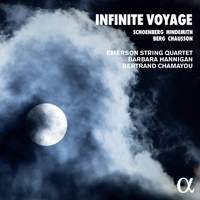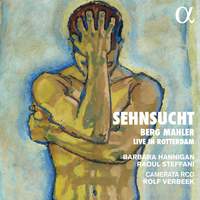Recording of the Week,
A fin-de-siècle voyage with Barbara Hannigan and the Emerson String Quartet
Hindemith’s Melancholie, inspired by the composer’s sense of desolation in the aftermath of the First World War, is a rare, welcome opportunity to experience his early, proto-Schoenbergian style rather than his commonly-heard later idiom. Unsurprisingly, given her affinity for repertoire of this period (as witness recent collaborations with pianist Reinbert de Leeuw and the Camerata RCO), Hannigan is especially skilful in capturing the paradoxical mood of the first text - childlike, naive, vulnerable, yet also tired, old and disillusioned. In the third, meanwhile, she responds perfectly to the pizzicato accompaniment’s oppressive, obsessive sound-world. The final movement’s Liebestod-ish mood is, by comparison, almost a relief; indeed the spirit of Wagner’s doomed heroine is never far away throughout the album.
Berg’s String Quartet No.3 - in part a love-letter to Helene Nahowski, whom he later married - continues this thread of yearning. The Emersons’ performance is striking not just for how the players lean into this mood (in particular with some sweeping, sighing portamentos) but for its textural clarity. The musical language Berg has developed by this point is frequently dense and chaotic, and without their ability to maintain lucidity and transparency, it’s easy to imagine things becoming incomprehensible.
Chausson’s style in his Chanson perpétuelle is perhaps more lyrically Romantic than that of the other works; the abandoned protagonist of his setting of Charles Cros’s words expresses herself in a way that is less overtly neurotic, though ultimately no less morbid, than Melancholie. Hannigan imbues her “character” with elements of both Mélisande and Ophelia. Although it’s clear from the opening stanzas that the love-affair is already in the past, her languid moments of reminiscence are nevertheless so convincing that it’s easy to be caught up in the rêverie, and thus to be caught off-guard by her turn back towards grief at the midpoint. The shades of mood that she finds in this miniature scena are incredible; rousing herself, towards the end, from resigned melancholy into an outpouring of Weltschmerz. By shaping the emotional contours so expertly, Hannigan makes the climactic top G# on “l’absent” feel like as much of a summation after seven minutes as Isolde’s “Welt” does after four hours.
The album culminates with Schoenberg’s enormously influential String Quartet No.2. Although, as musicologist Nicolas Derny observes in the notes, it’s futile to try and pin down the exact moment that conventional tonality finally snapped, this is as good a symbolic Rubicon as any. While tonal elements linger, the language is largely of a kind that, as in the Berg, benefits from the Emersons’ impressive sensitivity to polyphonic textures.
The symbolist poetry of Stefan George, set in the final two movements, evokes a complex kaleidoscope of connotations, seemingly uncertain as to whether death is a release from a wearying and dirtying world, or a joyfully impassioned transcendence. Hannigan is at her most expressionist here, with the descending compound minor ninth on “Liebe” absolutely living up to her own description of it as a “fin-de-siècle primal scream”; in the final movement she changes up through the emotional gears from otherworldly calm, via a sense of uneasy wonder, to an almost Mahlerian transfiguration.
Each of these works is in some sense challenging; musically, psychologically, or both. But there’s surely nobody better-placed than Barbara Hannigan to explore those darker musical corners, and her musical collaborators are second to none. For the Emersons, it not only looks back to their track-record of championing adventurous repertoire, but perhaps also echoes on a more personal level the bittersweetness of bidding farewell.
Barbara Hannigan (soprano), Bertrand Chamayou (piano), Emerson String Quartet
Available Formats: CD, MP3, FLAC, Hi-Res FLAC
Barbara Hannigan (soprano), Raoul Steffani (baritone), Camerata RCO, Rolf Verbeek
Available Formats: CD, MP3, FLAC, Hi-Res FLAC
Barbara Hannigan (soprano), Reinbert De Leeuw (piano)
Available Formats: CD, MP3, FLAC, Hi-Res FLAC, Hi-Res FLAC
Barbara Hannigan (soprano), Reinbert De Leeuw (piano)
Available Formats: 2 Vinyl Records, MP3, FLAC, Hi-Res FLAC, Hi-Res FLAC







